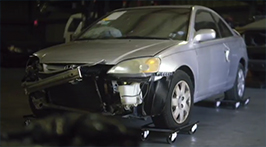Pressure-treated lumber is a popular construction material that is used where environmental factors could potentially damage wood. Through a variety of chemical treatments, the life of the wood is extended by protecting it against moisture, bugs, and other decay factors. However, some of these treatments have been shown to be unreliable and pose health hazards for consumers.
Uses of Pressure-Treated Lumber
Pressure-treated lumber is used in both interior and exterior construction. It is especially popular in outdoor construction, commercial building, and maritime installation, as the wood is rendered impervious to the elements. It can be buried without rotting, immersed in water without decay, and exposed to insects without fear of destruction.
The most common household uses for pressure-treated lumber are decking, playground structures, fencing, and siding for homes. The most common commercial uses for pressure-treated lumber are outdoor wooden seating, utility poles, guardrails, and railroad tracks. Maritime uses can include crane loaders, dock surfaces, and support structures for bridges, boat slips, and docks.
Dangers of Pressure-Treated Lumber
The main failure of pressure-treated lumber is not with the performance of the wood, but rather that the chemicals used in the treatment process are a danger to consumers. Over time, the chemicals have a tendency to leach into their surrounding environment, which can have a hazardous effect on humans who come into contact with the chemicals. This is a particular concern for householders, who may find themselves at risk due to the materials used in and around their home.
The newer pressure treated wood is processed with alternative coatings that are much less toxic. However, they too present some risks to consumers.
Chemical Leaching and Actions by the EPA
The first woods were treated with chemicals in the 1930s, but it wasn’t until the mid-1970s that the Environmental Protection Agency (EPA) started to take action against reports that the chemicals used in pressure-treated lumber were hazardous to individual health.
The EPA is mainly concerned with the levels of chromated copper arsenate (CCA) in pressure-treated lumber, as the arsenate in CCA is a type of arsenic, which is a carcinogenic. The arsenic levels in the wood have been shown to have a negative health effect on people in extended contact with the wood, or for example, when children touch the wood in play areas and then put their hands into their mouths. The industry withdrew CCA from almost all residential uses in 2003. By 2004, the CCA pressure-treated wood was phased out, and is no longer available to general consumers. Several alternative coatings were developed to replace CCA, including some using a copper base. Although CCA has been banned for residential use, it is still in use for some industrial and agricultural purposes.
The EPA and the U.S. Consumer Product Safety Commission (CPSC) believe that it is safe to leave old pressure-treated wood in place, stating that the toxic arsenate levels will be minimal as long as the treated wood receives a coating of pigmented, wood-penetrating oil sealant annually. However, some organizations, such as the Environmental Working Group (EWG), highly disagree with the EPA and CPSC findings. The EWG claim that their research proves the wood would have to be recoated every six months in order to be safe.
Injuries from Pressure-Treated Lumber
According to the National Academy of Sciences, long-term exposure to the arsenic that is found in some types of CCA-pressure-treated lumber can increase the risk of lung, bladder, and skin cancer over a person’s lifetime.
Specific Lumber that Poses a Danger
While other defective product listings may focus on specific brands, with pressure-treated lumber there are no brands to be targeted. Instead, the focus needs to be on the year that the wood was treated. The regulations surrounding the materials used in pressure-treated lumber shifted sharply in 1993, changing the chemical compound used to one that was less toxic to humans.
When looking to avoid pressure-treated lumber that is toxic, it is important to know the age of the wood. Woods processed before 1993 are highest in toxins, including arsenic. Any remodeling project involving older woods or any project utilizing reclaimed lumber should therefore be evaluated in light of the potential toxin exposure. Additionally, sapwoods are more commonly treated than heartwood timbers, so choice of wood may also be a factor in toxicity.
The hazards of CCA are most likely to affect young children who may possibly ingest the arsenic residual by hand-to-mouth actions after playing or crawling around on floors, decks, or play set equipment made with CCA-pressure treated wood before 2004.
Sources:
- Anonymous. “Pressure-Treated Wood – Its Uses, Limitations and Safety Considerations.” The Natural Handyman. Retrieved January 17 2010 from:www.naturalhandyman.com/iip/infxtra/infpre.html
- Knight Ridder News Service. (2004, May 4). “Treated Wood Is Cancer Risk For Kids”. Knight Ridder Newspapers.
- Schripps Howard News Service. (2004, June 9). “Wood Pesticide Still Used Despite Hazards.”
- Simpson Strongtie. (2008, September 4). “Pressure Treated Wood FAQs”. Retrieved January 17 2010 from http://www.strongtie.com/productuse/ptwoodfaqs.html
